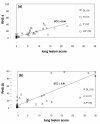A novel Respiratory Health Score (RHS) supports a role of acute lung damage and pig breed in the course of an Actinobacillus pleuropneumoniae infection
- PMID: 19383120
- PMCID: PMC2680854
- DOI: 10.1186/1746-6148-5-14
A novel Respiratory Health Score (RHS) supports a role of acute lung damage and pig breed in the course of an Actinobacillus pleuropneumoniae infection
Abstract
Background: Bacterial lung infections are a major cause of economic losses in the pig industry; they are responsible for approximately 50% of the antibiotics used in pigs and, therefore, also present an increasing concern to consumer protection agencies. In response to this changing market we investigated the feasibility of an old approach aimed at the breeding selection of more resistant pigs. As a first step in this direction we applied a new respiratory health score system to study the susceptibility of four different pig breeding lines (German Landrace, Piétrain, Hampshire, Large White) towards the respiratory tract pathogen Actinobacillus (A.) pleuropneumoniae.
Results: A controlled experimental aerosol infection with an A. pleuropneumoniae serotype 7 isolate was performed using 106 weaning pigs of defined breeding lines from the breeds German Landrace, Piétrain, Hamphire, and Large White. Pigs were clinically assessed on days 4 and 20 post infection following a novel scoring system, the Respiratory Health Score (RHS), which combines clinical, sonographic and radiographic examination results. The ranking on day 4 was significantly correlated with the ranking based on the pathomorphological Lung Lesion Score (LLS; Spearman Rank Correlation Coefficient of 0.86 [p < 0.0001]). Based on their RHS pigs were assigned to the different quartiles independent of the breeding line. The RHS-based rankings of pigs on day 4 and on day 20 were highly correlated (Spearman Rank Correlation Coefficient of 0.82 [p < 0.0001]) independent of the breeding line. Pigs of the Hampshire line were predominantly found in the lowest scoring quartile (47.6%) and absent in the highest scoring quartile. In contrast, pigs of the German Landrace and Piétrain breeding lines were predominantly found in the highest scoring quartile (32.3% and 35.7%, respectively).
Conclusion: These results demonstrate that the RHS obtained from live pigs shows a highly significant correlation to the lung lesion score considered as a "gold standard". The correlation of the ranking at days 4 and 20 post infection implies that the course of disease is highly dependent on the acute lung damage. The different severity of signs among the tested pig breeding lines clearly suggests a genetic difference in the susceptibility of pigs to A. pleuropneumoniae infection.
Figures



References
-
- Altrock Av. Occurrence of bacterial agents in lungs of pigs and evaluation of their resistance to antibiotics. Berl Munch Tierarztl Wschr. 1998;111:164–172. - PubMed
-
- Ross RF. Mycoplasma disease. In: Leman AD, Straw B, Glock R, Mengeling WL, D'Allaire S, Taylor DJ, editor. Disease of Swine. 7. Ames, Iowa State University Press; 1992. pp. 552–559.
-
- Sebunya TNK, Saunders JR. Haemophilus pleuropneumoniae infection in swine: a review. J Am Vet Med Assoc. 1983;182:1331–1337. - PubMed
-
- Noyes EP, Feeney D, Pijoan C. Comparison of the effect of pneumonia detected during lifetime with pneumonia detected at slaughter on growth in swine. J Am Vet Med Assoc. 1990;197:1025–1029. - PubMed
-
- Fenwick B, Henry S. Porcine pleuropneumonia. J Am Vet Med Assoc. 1994;204:1334–1340. - PubMed
Publication types
MeSH terms
LinkOut - more resources
Full Text Sources
Research Materials

